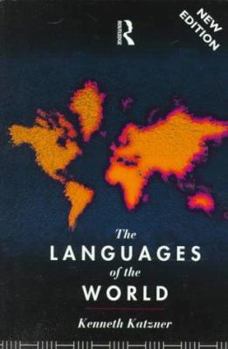The Languages of the World
Select Format
Select Condition 
Book Overview
This third edition of Kenneth Katzner's best-selling guide to languages is essential reading for language enthusiasts everywhere. Written with the non-specialist in mind, its user-friendly style and... This description may be from another edition of this product.
Format:Paperback
Language:English
ISBN:0415118093
ISBN13:9780415118095
Release Date:January 1995
Publisher:Routledge
Length:400 Pages
Weight:0.76 lbs.
Dimensions:1.0" x 5.1" x 7.8"
Age Range:18 years and up
Grade Range:Postsecondary
Customer Reviews
5 ratings
Lay linguistics
Published by Thriftbooks.com User , 16 years ago
This book is interesting to the language hobbyist. It has samples of many languages and the corresponding translations, plus a description of the place of the language in the area where it is spoken. A very enjoyable reference book to peak into from time to time.
Can Tell You A Lot About Languages--And The World
Published by Thriftbooks.com User , 21 years ago
Kenneth Katzner provides a well written and concisely presented book for those interested in the world's languages, their origins, growth and transformations, and linguistic relatives. The languages are listed by familial grouping, then individual languages, and then nation by nation. Easy-to-read charts elucidating families, sub-groups, branches, and major and minor languages are listed in the front of the book. Individually, the languages are listed in the index in the back of the book in alphabetical order making them easy to find and cross-reference. One can quickly find which languages are related via sub-families. You can bounce around from page to page with this. Each language listed is presented with a sample such as a poem or proverb followed by an English transliteration. Also included is the number of people who speak it, and in what different parts of the world. The languages' family, idiocyncracies, major grammar points, alphabet, and stresses are noted. As an example, here's a paraphrase of the Finnish language presented in the book:Spoken by 5 million speakers in Finland, 70,000 in the U.S., 200,000 in Sweden and 50,000 in Russia. Finnish is one of the few languages in Europe that is not of the Indo-European languages family. Like Estonian, it belongs to the Finno-Ugric languages which are a branch derived from the Uralic family. Finnish is difficult language to learn for Western native speakers because of it's non Indo-European origins and the the fact that it has 15 noun cases. Also in the beginning is a biography of the families of languages and explanations of the migrations of people, many thousands of years ago, that has created the current multi-varied linguistic make up of our world today.
killer handbook
Published by Thriftbooks.com User , 23 years ago
This is a well-written handbook to find out what language is spoken where and the history of its speakers. There are snippets of approximately 200 carefully chosen passages of representative literature shown both in their native alphabets and in English translation. A fun read, great reference, and very relevant to current events.The book is divided into three parts: an introduction to language families of the world, a listing of the individual languages themselves grouped in geographic order, and an alphabetically-arranged country-by-country survey of the languages spoken in each country. The section on language families describes relationships among language groups, a bit on the history of the people who speak them, and the geographical distribution of each family. The bulk of the book is in the second section on the individual languages. Each language is (usually) given a two-page description consisting of passages in their native script, along with an English translation, followed by a brief history of the language, its speakers, and the regions where the language is spoken. Examples of words that have found their way into English usage are also provided. The country survey consists of paragraph-long descriptions of the languages spoken in each country along with the number of speakers for each language.Katzner's book is geared for the general reader who may be more interested on how languages relate to the countries where they are spoken rather than the morphology and syntax of a particular language. Those who prefer a more linguistic-oriented approach should try Concise Compendium of the Worlds Languages by George L. Campbell. It is as well written as Katzner's book but contains more detail on phonology and grammar. Both have excellent depictions of native alphabets with Katzner using examples from classic literature (e.g. Flaubert in French, Iqbal in Urdu, and Tagore in Bengali) whereas Campbell uses a passage from the Gospel of St John to illustrate the written form of the language. If your interest includes knowing what consonants are affricates, fricatives, or semi-vowels then look into Campbell's book. But if you want to know a little something about who speaks Pashto or about what are the dominant languages in India or other similar sorts of information then Katzner's book is for you.
An enormously useful book!
Published by Thriftbooks.com User , 27 years ago
Here at work (a translation company), we use this book constantly for reference. It has been invaluable for quickly finding concise information and background on specific languages, and we find the written examples especially useful. A great book for very little money!
A really cool book
Published by Thriftbooks.com User , 27 years ago
This is a great book for becoming aware of the languages spoken on our planet. You can look up a given language & see a text taken from the traditions of that language followed by a translation before reading the article about that language. It also has a section on language families, and a country-by-country survey of languages. Very interesting reading and useful for gaining an overview of the world's languages.





